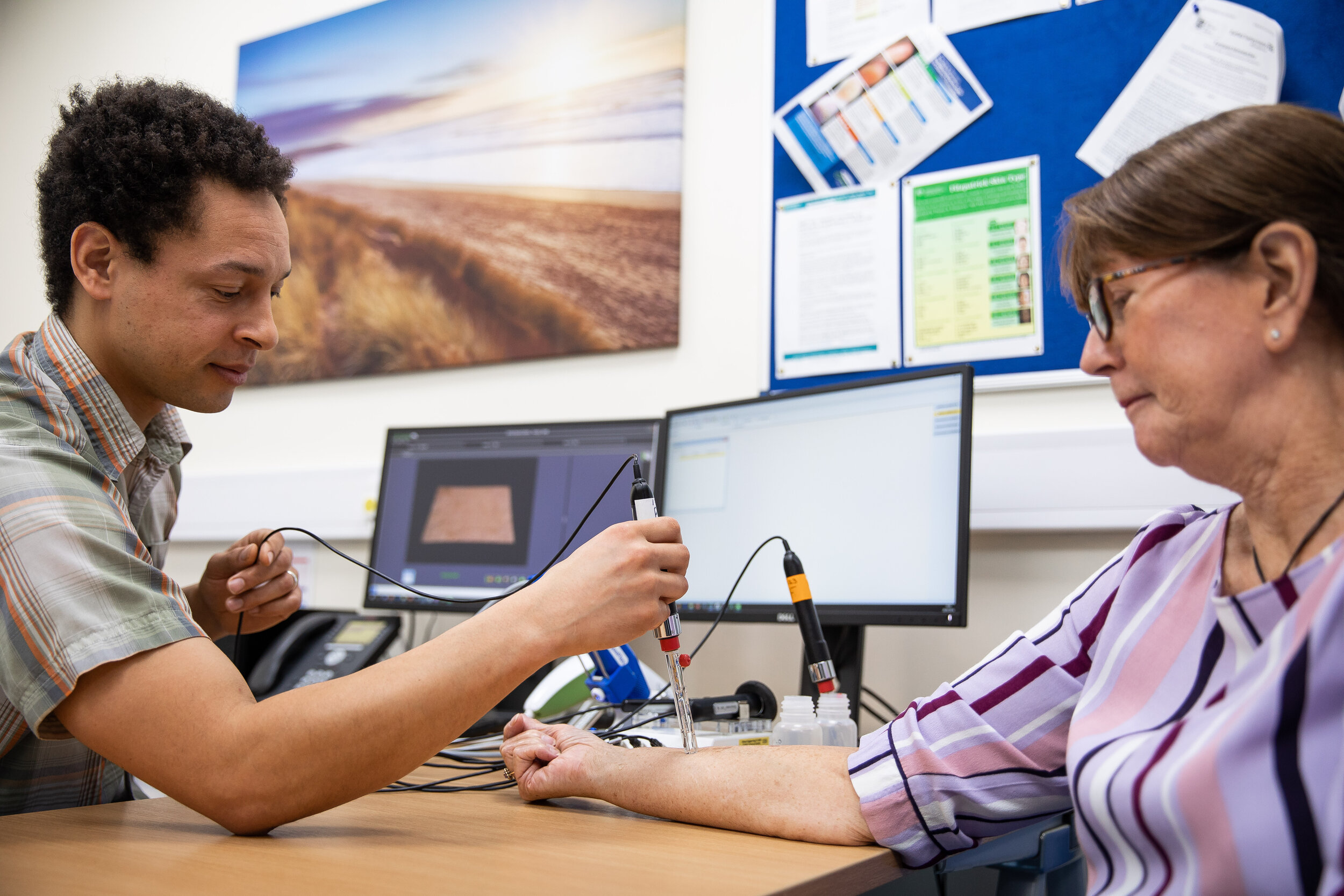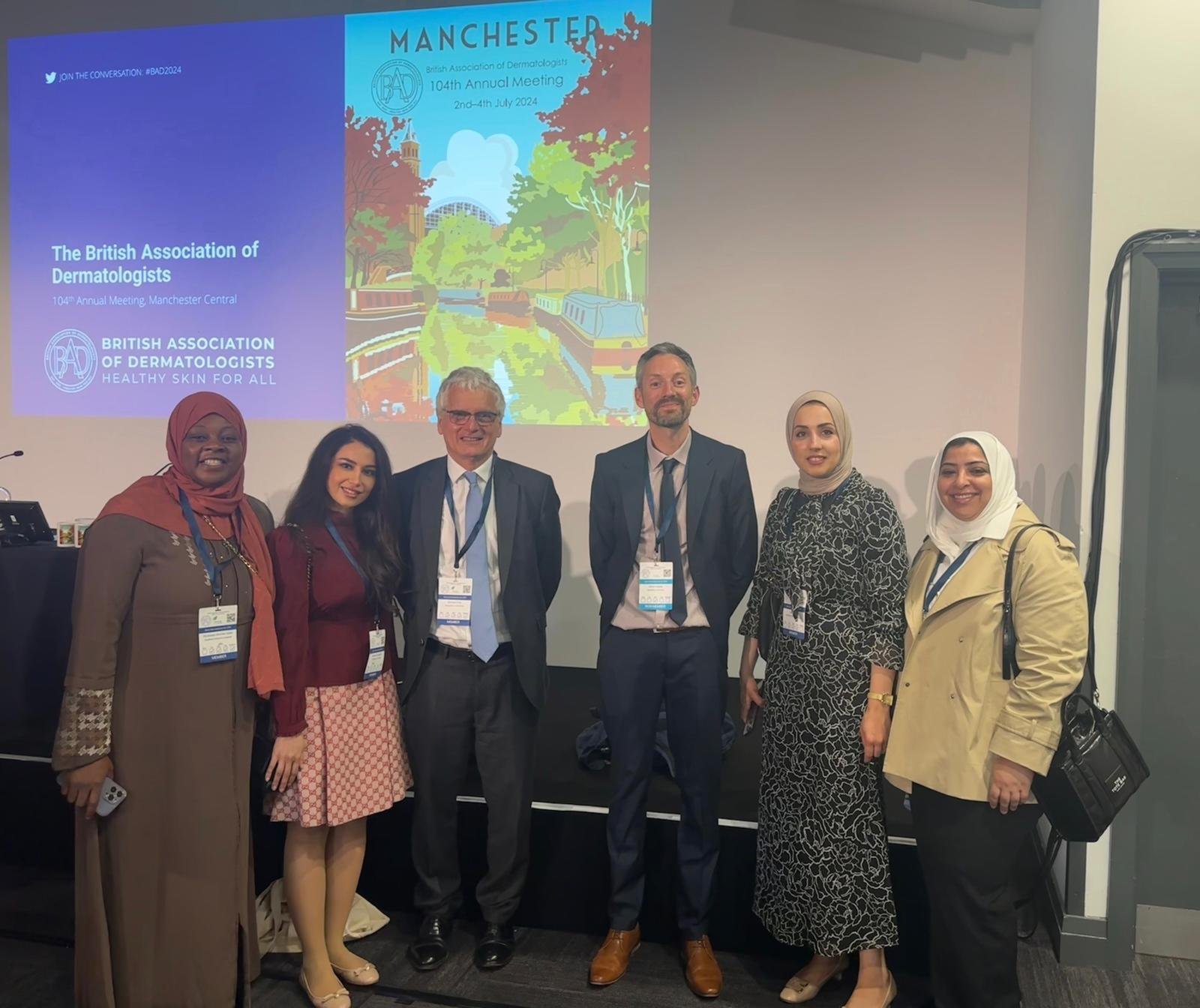Our Environment
The Sheffield Dermatology Research (SDR) group is proud to be part of the following University of Sheffield and Sheffield NHS hospitals, departments and clinical research facilities:
Division of Clinical Medicine, School of Medicine & Population Health, University of Sheffield
Our research in human participants is split between three core facilities:
Sheffield Dermatology Research Skin Barrier Lab
The Sheffield Children’s Hospital Clinical Research Facility (CCRF)
The Sheffield Teaching Hospitals NIHR Clinical Research Facility (CRF)
The Rupert Hallam Department of Dermatology, Sheffield Teaching Hospitals
The Department of Paediatric Dermatology Sheffield Children’s Hospital
The Jessop Wing, Maternity Hospital
Division of Clinical Medicine, School of Medicine & Population Health, University of Sheffield
The Department combines basic science research in molecular cell biology, with a particular focus on innate immunity in Dermatology, Respiratory Medicine, Infectious Diseases, Renal Medicine, Cancer and Rheumatology. The department comprises 33 academic staff and occupies laboratory and office space within the Medical School and the Royal Hallamshire Hospital. There is access to core facilities in proteomics and genomics, high quality Cell Biology, Containment Level 2 and Containment Level 3 laboratories. Our clinical base is at both the Royal Hallamshire (Dermatology, Infectious Diseases, Respiratory Medicine and Rheumatology) and Northern General (Renal Medicine and Cardiovascular) Hospitals.
The University of Sheffield is in the top 10 of the UK Russell Group in clinical medicine, for combined world leading and internationally excellent outputs. In the 2014 Research Assessment Exercise, Sheffield and IC were both ranked 1st in Biomedical Sciences and General Engineering respectively.
Sheffield Dermatology Research is part of the immunity theme in the Division of Clinical Medicine. This research is focussed on understanding the mechanisms of physiological and pathological immune responses, which lead to inflammation. We study these immune mechanisms in a range of organs, relevant to human disease, including the skin, lung, kidney, the gastro-intestinal, vascular systems and the brain.
Gene-environment interactions in atopic dermatitis
Inflammation in the skin leads to and/or is associated with inflammation in every other part of the body. Understanding and treating immune dysregulation/inflammation in the skin can help understand and treat immune dysregulation/inflammation in every other part of the body. This is because immune dysregulation leading to inflammation in the skin leads to systemic inflammation which causes or is associated with diseases such as asthma, food allergy, inflammatory bowel disease, autism, ADHD, cardiovascular, depression.
Skin barrier challenge elects an abnormal response in atopic dermatitis
A major focus of SDR’s research is atopic dermatitis. Atopic dermatitis is caused by an abnormal immune response to environmental agents that would normally be harmless. This leads to cutaneous and then systemic inflammation. It is also associated with allergen penetration and sensitisation.
Atopic dermatitis: a systemic disease
The research within Sheffield Dermatology Research also covers every other theme within the Division of Clinical Medicine.
Imaging Theme: Optical cohesive tomography (OCT): Sub-clinical atopic dermatitis
Infection Theme: Antimicrobial peptides (LL-37): Defending the skin against infection
Cardiovascular Theme:
Sheffield Dermatology Research Skin Barrier Lab

The skin barrier lab is a core facility based around a suite of consultation/treatment rooms dedicated to skin research studies in human participants. Being fully climate controlled the rooms provide the optimum conditions for biophysical skin assessments, such as TEWL measurements. A portfolio of specialist skin diagnostic and analytical equipment is available, including ATR-FTIR spectroscopy and optical coherence tomography. The lab acts as a hub for an experienced team of clinical investigators, skin research technicians, and bioengineers. The team has extensive experience in conducting functional mechanistic studies at the skin barrier lab, investigating a range of topical dermatological interventions in adults. For clinical research involving investigational medicinal products or vulnerable people (i.e. neonates) the team works with the STH NIHR CRF and SCH CCRF using the skin barrier lab as a technical base.
The Sheffield Children’s Hospital Clinical Research Facility (CCRF)
The Sheffield Children’s Hospital Research and Innovation Department is dedicated to the development of medicines and treatments for children. Innovating in children’s healthcare is also a key priority for the Trust.
Our Research strengths cover a wide range of clinical specialties and we are proud to work with some of the country’s leading professionals in paediatric conditions.
The Sheffield Children’s Clinical Research Facility (CCRF) opened in 2008 and was the first paediatric clinical research facility in the UK.
Research and Innovation at Sheffield Children’s NHS Foundation Trust includes the Research Administration and Governance Team and the Clinical Research Facility Team. Together we provide comprehensive assistance to researchers conducting clinical research in our Trust.
We work closely with colleagues in the NIHR CRN: Yorkshire and Humber, regional NHS trusts and our local universities to ensure that we provide a streamlined service for the development, set-up, costing and management of both paediatric and adult research conducted at Sheffield Children’s NHS Foundation Trust.
Sheffield Dermatology Research have led/are leading clinical trials of biologics, small molecules and topical drugs for the treatment of children with atopic dermatitis. For children with severe atopic dermatitis who have failed to respond to all currently available therapies, these trials provide an opportunity to access novel highly effective medicines.
We are delighted that Sheffield Dermatology Research is opening a paediatric Skin barrier CRF within SCH CRF to expand the number of Dermatology clinical trials we can conduct. A list of our paediatric dermatology trials can be found in the ‘Research’ section of this website.
The CRF at Sheffield Children's Hospital opened in 2008 and we first started supporting Dermatology research in 2015. We are a team of nurses, officers, data managers and research assistants and specialise in the delivery of clinical research in children. We support a growing portfolio of studies and trials in dermatology and other specialties across the Trust. As a clinical research delivery team, we work closely with the dermatology clinical team to identify suitable patients for trials and research and ensure continuity of their clinical care alongside their participation in research.
We have been fortunate to work closely with patients, to see the young people grow into young adults and benefit from the great improvements in their atopic dermatitis, thanks to new medication. We hope this is just the start of more treatments for children with chronic dermatology conditions and we look forward to supporting many more trials in the future.
As the trials continue, we look forward to utilising the new biomarker technology in skin assessments and providing the optimum physical environment for conducting these important trials.
Sheffield Children’s Hospital CCRF Experimental Dermatology Facility
Taking OCT measurements in the PELISTAD Dupilumab trial
SCH CCRF child-friendly environment where even your teddy bear is welcome
The Sheffield Teaching Hospitals NIHR Clinical Research Facility (CRF)
The Clinical Research Facility (CRF) based in the city of Sheffield, UK, provides a specialist environment at both the Royal Hallamshire Hospital (including the Jessop Wing’s maternity ward) and the Northern General Hospital, for the conduct of high-quality clinical research. Patients and healthy volunteers are guaranteed that research undertaken in the CRF has met all the legislative, governance and ethical requirements that ensure participant safety. The CRF Manager, Lead Nurse and Research Matrons, along with their team of clinical and administrative research support staff, work extensively with investigators to ensure full use of CRF resources.
The CRF offers dedicated space for all types of clinical research including industry and experimental medicine studies. The Facility has the capacity to care for participants on a daily and overnight basis. The CRF has the range of expertise required to run complex studies with small numbers of patients as well as large healthy volunteer studies where the recruitment of hundreds of people is necessary. The CRF can also provide an outreach service for studies that depend upon delivering in their own clinical environment.
SDR delivers trials of new biologics and small molecule treatments for atopic dermatitis in adults, within the STH NIHR CRF. Clinical trials give patients access to new medicines up to five years before they are available in our NHS clinics. These trials have transformed the lives of many of our patients with severe atopic dermatitis. A list of some of our clinical trials can be found in the ‘Research’ section of this website.
The Rupert Hallam Department of Dermatology, Sheffield Teaching Hospitals
The Rupert Hallam Department of Dermatology, based on C Floor of the Royal Hallamshire Hospital, diagnoses and treats people for all types of skin disorder, including eczema (dermatitis), psoriasis alopecia, vitiligo and melanoma. A number of clinics led by nurses are held each week to see patients needing treatments such as phototherapy, where ultraviolet light is used to help skin heal, leg ulcer treatments, and patch testing to find out what kind of skin disorder the patient has. Skin surgery is also carried out and the Dermatology department provides an 8-bedded ward for patients. The department works very closely with doctors and nurses in the community where there is a very successful minor skin surgery service led by three doctors with a special interest in dermatology.
The Department of Paediatric Dermatology Sheffield Children’s Hospital
British Society for Paediatric Dermatology meeting at Sheffield Children’s Hospital 2016
SDR have led clinical trials of biologics, small molecules and topical drugs for the treatment of children with atopic dermatitis. For children who are not able to obtain a place in clinical trials we work with our partners in the Pharmaceutical industry to provide new drugs on a compassionate basis until they are available through the NHS.
The British Association of Dermatologists meeting, Manchester 2024
The Department of Paediatric Dermatology at SCH provides a local and regional service for babies to adolescents for all skin diseases. For atopic dermatitis (atopic eczema) we provide a national service for children with very severe atopic dermatitis who are unresponsive to all current therapies available on the NHS. The clinical service is integrated with the SCH CRF in order to provide a transition into and out of clinical trials.
Thank you very much to two wonderful boys for this beautiful NHS rainbow
The Jessop Wing, Maternity Hospital
The Jessop Wing opened in 2001 and is a purpose built maternity unit where approximately 7,000 babies are born every year. Sheffield Dermatology Research with the Research Midwife Team conducts clinical trials in new born babies. These trials investigate how topical oils, emollients, wash products and water influence the integrity of the babies’ skin and the development of atopic dermatitis and allergy. Babies recruited into long term trials are followed up in the SCH CRF. A list of some of our clinical trials can be found in the ‘Research’ section of this website.
















